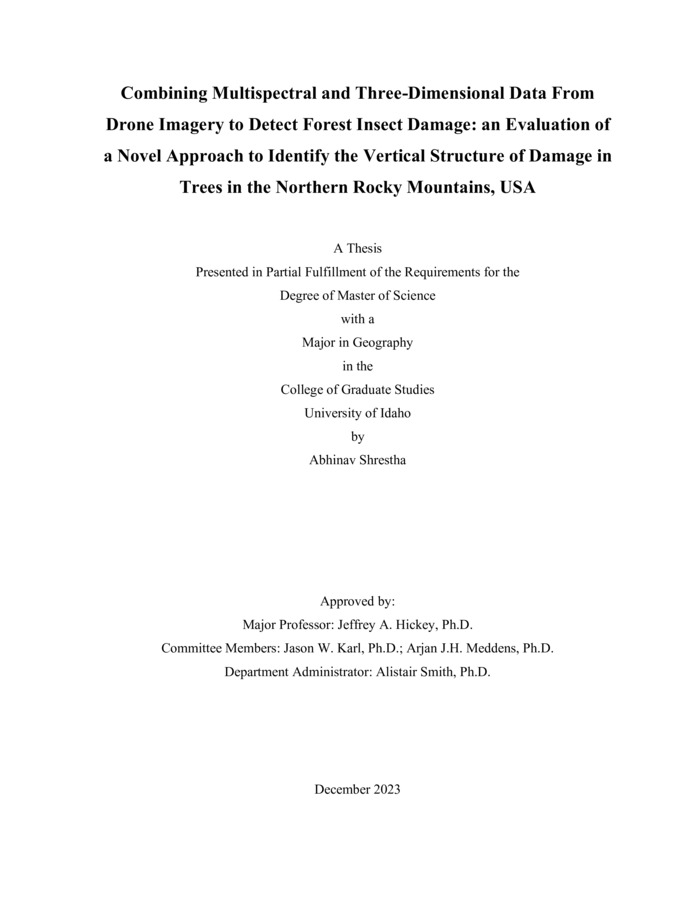Combining multispectral and three-dimensional data from drone imagery to detect forest insect damage: an evaluation of a novel approach to identify the vertical structure of damage in trees in the northern Rocky Mountains, USA
Shrestha, Abhinav. (2023-12). Combining multispectral and three-dimensional data from drone imagery to detect forest insect damage: an evaluation of a novel approach to identify the vertical structure of damage in trees in the northern Rocky Mountains, USA. Theses and Dissertations Collection, University of Idaho Library Digital Collections. https://www.lib.uidaho.edu/digital/etd/items/shrestha_idaho_0089n_12765.html
- Title:
- Combining multispectral and three-dimensional data from drone imagery to detect forest insect damage: an evaluation of a novel approach to identify the vertical structure of damage in trees in the northern Rocky Mountains, USA
- Author:
- Shrestha, Abhinav
- ORCID:
- 0009-0007-1904-7457
- Date:
- 2023-12
- Keywords:
- drones forest health monitoring point cloud remote sensing structure-from-motion top-kill detection
- Program:
- Earth and Spatial Sciences
- Subject Category:
- Geography
- Abstract:
-
Remote sensing is a well-established tool for detecting forest disturbances. The increased availability of Uncrewed Aerial Systems (drones) and advances in computer algorithms have resulted in an increase in studies of forest insects using drones. To date, most studies have used height information from three-dimensional (3D) point clouds to segment individual trees and have used two-dimensional multispectral images to identify tree damage. Here, I describe a novel approach of classifying the multispectral reflectances of the 3D point cloud into damaged and healthy classes, retaining the height information for assessment of the vertical distribution of damage within a tree. Drone images were acquired in a study area in the Northern Rocky Mountains that experienced recent damage from insects and processed to produce a point cloud. A random forest (RF) classification model was developed from the multispectral data of these points, which had an overall accuracy (OA) of 98.6% and, when applied across the study area, classified 77% of the points with a confidence of greater than 75%. Based on these classified points and segmented trees, I developed and evaluated algorithms to separate healthy and damaged trees, and for damaged trees, identified multiple damage types based on percentages of red and gray points on each tree. Healthy and damaged trees were identified with high accuracy (OA: 93.5%), with most of the trees in the 27-ha study area classified as healthy (78.3%). The remaining damaged trees were separated into different damage types with moderate accuracy (OA: 70.1%). A subsequent algorithm identified top-kill with high accuracy (OA: 91.8%), with most damaged trees in the study area exhibiting top-kill (78.9%). Our results demonstrate the utility of drone data for monitoring the vertical structure of tree damage from forest insects and diseases.
- Description:
- masters, M.S., Earth and Spatial Sciences -- University of Idaho - College of Graduate Studies, 2023-12
- Major Professor:
- Hicke, Jeffrey A.
- Committee:
- Karl, Jason W.; Meddens, Arjan J.H.; Smith, Alistair
- Defense Date:
- 2023-12
- Identifier:
- Shrestha_idaho_0089N_12765
- Type:
- Text
- Format Original:
- Format:
- application/pdf
- Rights:
- In Copyright - Educational Use Permitted. For more information, please contact University of Idaho Library Special Collections and Archives Department at libspec@uidaho.edu.
- Standardized Rights:
- http://rightsstatements.org/vocab/InC-EDU/1.0/

